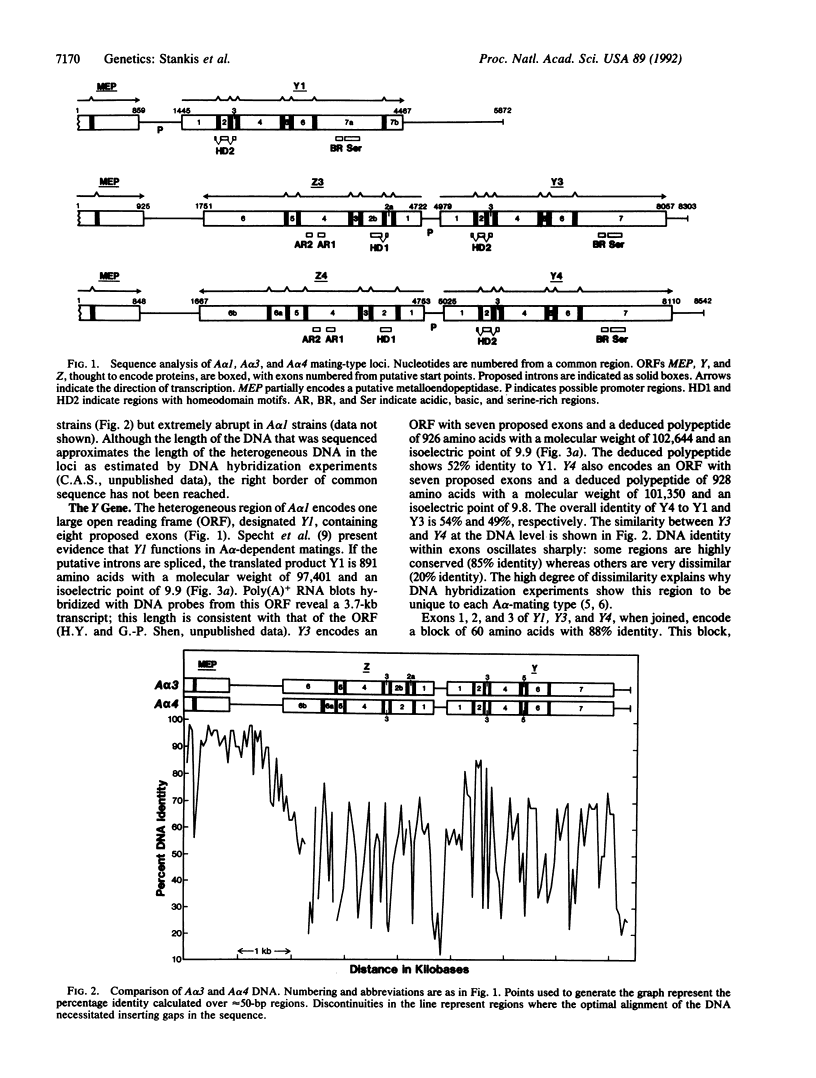Abstract
The A alpha mating locus is one of four multiallelic loci that govern sexual development in the basidiomycete fungus Schizophyllum commune. We have determined the nucleotide sequence encoding three A alpha mating types, A alpha 1, A alpha 3, and A alpha 4. We have found that the locus for A alpha 3 and A alpha 4 consists of two genes: Y and Z. The locus for A alpha 1 encodes only one gene, Y. The Z polypeptides encoded by different alleles exhibit 42% identity. The Y polypeptides exhibit 49-54% identity. The finding that the deduced Z and Y polypeptides have homeodomain motifs suggests that these polypeptides may be DNA-binding regulatory proteins that control the expression of developmental genes. The deduced Z polypeptide also has acidic regions that might be functionally analogous to the acidic regions in yeast GAL4 and GCN4 that activate transcription. The Y polypeptide has a serine-rich region and a basic region that shows some identity to the lysine-rich region of H1 histones.
Full text
PDF




Selected References
These references are in PubMed. This may not be the complete list of references from this article.
- Dons J. J., Mulder G. H., Rouwendal G. J., Springer J., Bremer W., Wessels J. G. Sequence analysis of a split gene involved in fruiting from the fungus Schizophyllum commune. EMBO J. 1984 Sep;3(9):2101–2106. doi: 10.1002/j.1460-2075.1984.tb02097.x. [DOI] [PMC free article] [PubMed] [Google Scholar]
- Dranginis A. M. Binding of yeast a1 and alpha 2 as a heterodimer to the operator DNA of a haploid-specific gene. Nature. 1990 Oct 18;347(6294):682–685. doi: 10.1038/347682a0. [DOI] [PubMed] [Google Scholar]
- Giasson L., Specht C. A., Milgrim C., Novotny C. P., Ullrich R. C. Cloning and comparison of A alpha mating-type alleles of the Basidiomycete Schizophyllum commune. Mol Gen Genet. 1989 Jul;218(1):72–77. doi: 10.1007/BF00330567. [DOI] [PubMed] [Google Scholar]
- Gillissen B., Bergemann J., Sandmann C., Schroeer B., Bölker M., Kahmann R. A two-component regulatory system for self/non-self recognition in Ustilago maydis. Cell. 1992 Feb 21;68(4):647–657. doi: 10.1016/0092-8674(92)90141-x. [DOI] [PubMed] [Google Scholar]
- Goutte C., Johnson A. D. a1 protein alters the DNA binding specificity of alpha 2 repressor. Cell. 1988 Mar 25;52(6):875–882. doi: 10.1016/0092-8674(88)90429-1. [DOI] [PubMed] [Google Scholar]
- Herskowitz I. A regulatory hierarchy for cell specialization in yeast. Nature. 1989 Dec 14;342(6251):749–757. doi: 10.1038/342749a0. [DOI] [PubMed] [Google Scholar]
- Hope I. A., Struhl K. Functional dissection of a eukaryotic transcriptional activator protein, GCN4 of yeast. Cell. 1986 Sep 12;46(6):885–894. doi: 10.1016/0092-8674(86)90070-x. [DOI] [PubMed] [Google Scholar]
- Jongeneel C. V., Bouvier J., Bairoch A. A unique signature identifies a family of zinc-dependent metallopeptidases. FEBS Lett. 1989 Jan 2;242(2):211–214. doi: 10.1016/0014-5793(89)80471-5. [DOI] [PubMed] [Google Scholar]
- Koltin Y., Raper J. R., Simchen G. The genetic structure of the incompatibility factors of Schizophyllum commune: the B factor. Proc Natl Acad Sci U S A. 1967 Jan;57(1):55–62. doi: 10.1073/pnas.57.1.55. [DOI] [PMC free article] [PubMed] [Google Scholar]
- Kozak M. An analysis of 5'-noncoding sequences from 699 vertebrate messenger RNAs. Nucleic Acids Res. 1987 Oct 26;15(20):8125–8148. doi: 10.1093/nar/15.20.8125. [DOI] [PMC free article] [PubMed] [Google Scholar]
- Kronstad J. W., Leong S. A. Isolation of two alleles of the b locus of Ustilago maydis. Proc Natl Acad Sci U S A. 1989 Feb;86(3):978–982. doi: 10.1073/pnas.86.3.978. [DOI] [PMC free article] [PubMed] [Google Scholar]
- Ma J., Ptashne M. Deletion analysis of GAL4 defines two transcriptional activating segments. Cell. 1987 Mar 13;48(5):847–853. doi: 10.1016/0092-8674(87)90081-x. [DOI] [PubMed] [Google Scholar]
- May G., Le Chevanton L., Pukkila P. J. Molecular analysis of the Coprinus cinereus mating type A factor demonstrates an unexpectedly complex structure. Genetics. 1991 Jul;128(3):529–538. doi: 10.1093/genetics/128.3.529. [DOI] [PMC free article] [PubMed] [Google Scholar]
- Pearson W. R., Lipman D. J. Improved tools for biological sequence comparison. Proc Natl Acad Sci U S A. 1988 Apr;85(8):2444–2448. doi: 10.1073/pnas.85.8.2444. [DOI] [PMC free article] [PubMed] [Google Scholar]
- Pierotti A., Dong K. W., Glucksman M. J., Orlowski M., Roberts J. L. Molecular cloning and primary structure of rat testes metalloendopeptidase EC 3.4.24.15. Biochemistry. 1990 Nov 13;29(45):10323–10329. doi: 10.1021/bi00497a006. [DOI] [PubMed] [Google Scholar]
- Raper J. R., Baxter M. G., Middleton R. B. THE GENETIC STRUCTURE OF THE INCOMPATIBILITY FACTORS IN SCHIZOPHYLLIUM COMMUNE. Proc Natl Acad Sci U S A. 1958 Sep 15;44(9):889–900. doi: 10.1073/pnas.44.9.889. [DOI] [PMC free article] [PubMed] [Google Scholar]
- Sanger F., Nicklen S., Coulson A. R. DNA sequencing with chain-terminating inhibitors. Proc Natl Acad Sci U S A. 1977 Dec;74(12):5463–5467. doi: 10.1073/pnas.74.12.5463. [DOI] [PMC free article] [PubMed] [Google Scholar]
- Schulz B., Banuett F., Dahl M., Schlesinger R., Schäfer W., Martin T., Herskowitz I., Kahmann R. The b alleles of U. maydis, whose combinations program pathogenic development, code for polypeptides containing a homeodomain-related motif. Cell. 1990 Jan 26;60(2):295–306. doi: 10.1016/0092-8674(90)90744-y. [DOI] [PubMed] [Google Scholar]
- Schuren F. H., Wessels J. G. Two genes specifically expressed in fruiting dikaryons of Schizophyllum commune: homologies with a gene not regulated by mating-type genes. Gene. 1990 Jun 15;90(2):199–205. doi: 10.1016/0378-1119(90)90180-y. [DOI] [PubMed] [Google Scholar]
- Scott M. P., Tamkun J. W., Hartzell G. W., 3rd The structure and function of the homeodomain. Biochim Biophys Acta. 1989 Jul 28;989(1):25–48. doi: 10.1016/0304-419x(89)90033-4. [DOI] [PubMed] [Google Scholar]
- Specht C. A., Stankis M. M., Giasson L., Novotny C. P., Ullrich R. C. Functional analysis of the homeodomain-related proteins of the A alpha locus of Schizophyllum commune. Proc Natl Acad Sci U S A. 1992 Aug 1;89(15):7174–7178. doi: 10.1073/pnas.89.15.7174. [DOI] [PMC free article] [PubMed] [Google Scholar]
- Tymon A. M., Kües U., Richardson W. V., Casselton L. A. A fungal mating type protein that regulates sexual and asexual development contains a POU-related domain. EMBO J. 1992 May;11(5):1805–1813. doi: 10.1002/j.1460-2075.1992.tb05232.x. [DOI] [PMC free article] [PubMed] [Google Scholar]
- Ullrich R. C., Specht C. A., Stankis M. M., Yang H., Giasson L., Novotny C. P. Molecular biology of mating-type determination in Schizophyllum commune. Genet Eng (N Y) 1991;13:279–306. doi: 10.1007/978-1-4615-3760-1_13. [DOI] [PubMed] [Google Scholar]


